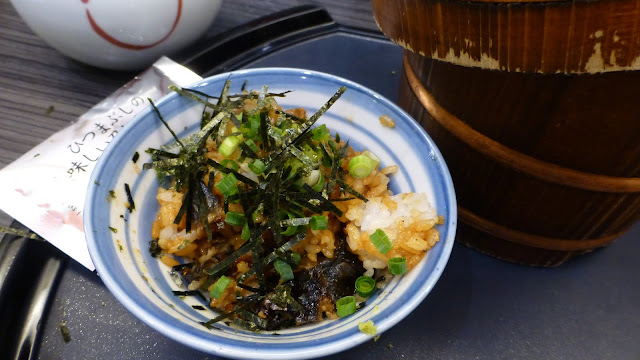Before I flew off to Nagoya, I emailed my long time gourmet friend Abe san and asked for recommendations on local specialties. He wrote back to say that a grilled eel dish called hitsumabushi was definitely the must-try.
After grazing on tebasaki at Izakaya Tsuruhachi (see previous post), I was now ready for the main event -- dinner.
I went to Nagoya Station since I knew there would be a food area somewhere inside.
This is Umaimon Dori -- umai means yummy and dori means street so I am guessing it somehow translates to Yummy Street.
All the big train stations in Japan have sections like this where restaurants, coffee shops and food sellers can be found. Nagoya Station has more than one food area -- there's another in the basement and a slightly more premium one in the higher floors.
But Umaimon Dori is the most convenient, specially for those just getting off or on the bullet train.
The lighted sign showed some of the different cafes and restaurants available -- a few izakayas, a soba place, a ramen restaurant, a pastry shop, a Chinese restaurant and (shudder) Starbucks and (double shudder) Mcdonalds.
As a saving grace, there was also an eel restaurant, and famous for hitsumabushi at that!
This is the entrance to a branch of Maruya Honten set inside Umaimon Dori. Maruya Honten is one of the best hitsumabushi restaurants in Nagoya and is rated very highly in all the food sites and blogs.
Because it was past 8 p.m. the evening crowd had come and gone so I was promptly led to a table.
Because it was past 8 p.m. the evening crowd had come and gone so I was promptly led to a table.
I was not as hungry as I usually am (I blame the tebasaki and the beer) so I opted for the smallest order that consists of half an eel and cost a little over 2,000 yen.
The regular sized order contains a whole eel while the larger portion for bigger appetites (and bigger budgets) comes with an eel and a half.
Abe san had vaguely told me how to eat hitsumabushi, differently from unadon which is the usual grilled eel on top of rice.
Maruya Honten has the instructions on the full hitsumabushi experience printed on the back of its menu complete with english translations.
As I waited for my food, I took the time to read them carefully.
My order arrived after a few minutes and it certainly looked more substantial than just half an eel. The eel is served on top of rice in a wooden barrel.
The set tray comes with miso soup, the requisite tsukemono or pickles and small dishes containing various condiments. The small foil packet contains nori strips.
The set tray comes with miso soup, the requisite tsukemono or pickles and small dishes containing various condiments. The small foil packet contains nori strips.
Here's the step-by-step guide to enjoy hitsumabushi in three ways.
First, break up and mix the eel and rice together. Take a small portion and put it in your bowl and enjoy. This tasted just like unadon -- grilled eel basted with a teriyaki type sauce, served on top of rice.
For the second way, the different condiments come into play -- wasabi, chopped green onion, thinly sliced blue perilla leaves and nori strips.
Refill your bowl with a bit more of eel and rice and top with as little or as much of the condiments as you like. I loved the minty, citrusy taste of the perilla leaves which added a refreshing and light note to the grilled eel.
The waitstaff unobtrusively walk around and once they see you are well in to your second bowl, they come over with a small pot of hot, very light dashi or broth which is used in the third way of eating this unique Nagoyan dish.
Adding more eel, rice and condiments on your bowl, pour on the broth to create something like an eel o-chazuke (rice with soup). While o-chazuke is one of the few Japanese dishes I do not enjoy, I was surprised to find myself liking this hitsumabushi version.
This is how my rice bowl with eel and broth looked like. As you can see, the rice and eel kept their texture and consistency and did not turn into a sludgy porridge.
Finally, if you have some eel and rice and condiments left, the last step in finishing your hitsumabushi is to go back and have it the way that you liked the best.
I preferred the second way -- eel and rice enhanced with the wasabi, onions and perilla leaves and topped with the last of the thin, crisp nori. The condiments are refilled for free so don't be shy and ask for some more if you need it.
It was so good I ate it all ... down to the last grain of soft sticky rice.
After eating, you bring your bill (discreetly tucked under your tray) to the counter outside where you pay. If you feel like enjoying Maruya Honten's famous grilled eel at home or if you're heading somewhere and want to give it as omiyage or souvenir, you can buy boxes for take out.
Maruya Honten closes at 10 p.m. and I just barely made the last order. I walked the few hundred meters back to my hotel with the bright lights of Nagoya Station all lit up behind me.
There were still many people in the streets and inside the coffee shops and bars around the station. A few of the big electronic stores were still open.
But no more coffee or shopping for me tonight.
I was replete and satisfied. Onaka ga ippai, in more ways than one.
It was a foodie evening to remember, on my first and only night in Nagoya City.
Gochisousama deshita!

















No comments:
Post a Comment